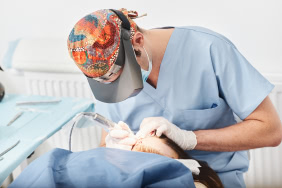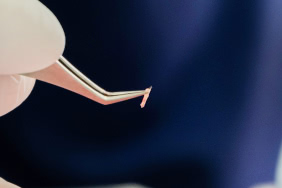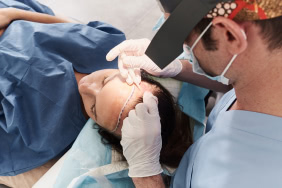- Strona główna
- /
- Hair transplant
FUE hair
transplant
The Follicular Unit Expansion (FUE) method is the latest and most sophisticated hair transplantation method in the world.
By sourcing individual hair follicles (grafts), we eliminate the linear scar, as it was earlier the case with FUT (the so-called strip) procedures.
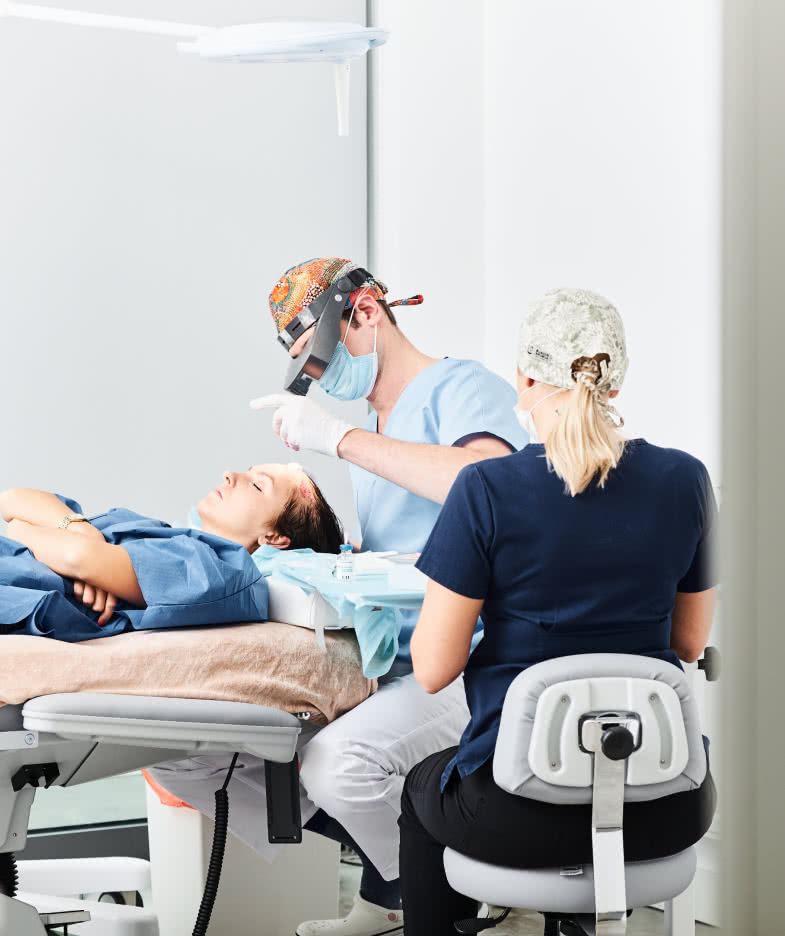
A specially designed tool is used to implant the follicle at the desired angle and direction.
These are key elements for the hair to grow and set naturally after the treatment. Of course, the tool itself is not a guarantee of natural appearance. Physician’s knowledge and experience help to achieve this effect, and the tool merely makes the work easier and quicker.
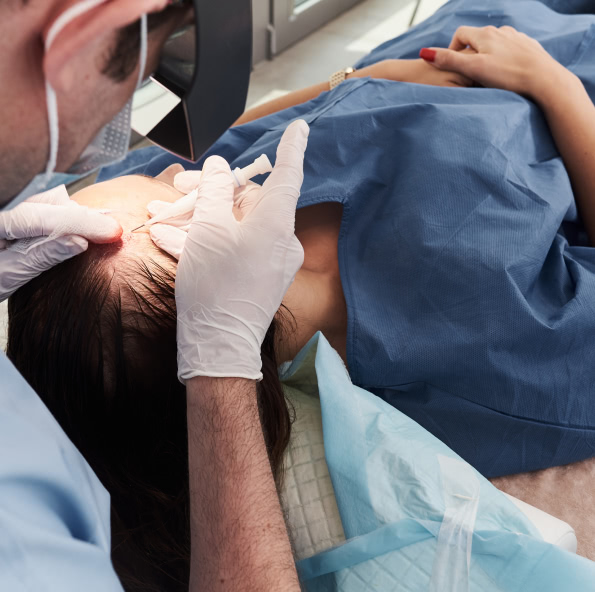
Implanters, similarly to robots and other “revolutionary” hair-collection machines, are merely tools that may not produce the desired results when used by inexperienced hands.
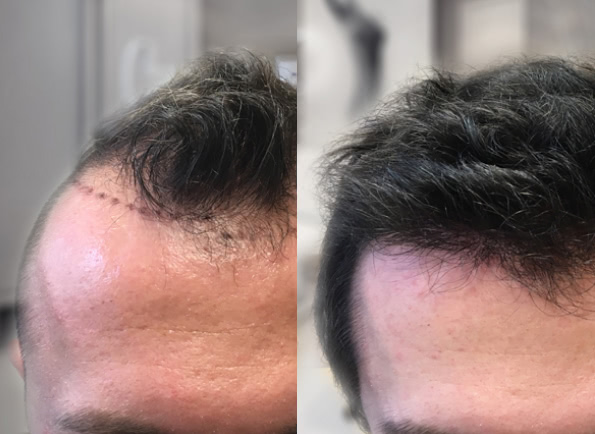
Based on this knowledge, researchers started trying to move this strong hair to a place where patients no longer have it, most often to the receding hairline and head crown. That is why the back and the sides of the head are often referred to as donor areas.
It is from these areas that the surgeon collects hair follicles. The first transplantations consisted of cutting a hairy part of the skin and transplanting it to a place deprived of hair.
A more natural look was only achieved after the Strip method was invented. The FUE hair transplant method is the most recent, the least invasive method not leaving visible traces of surgery. In this case, individual hair follicles are collected without using a scalpel. Hair transplant is a permanent method of hair recovery on the scalp. The hair sourced from the back and sides of the head is more resistant to falling out (note that people who have lost their hair still have a lot of it at the back and on the sides of their head). With this knowledge, we can move this “strong” and durable hair in areas in need of hair thickening or restoration.

The follicles are picked one by one with a 0.8–1.0mm diameter tool. This treatment is labour- and time-consuming, but less invasive than the FUT (strip) procedure, which potential complication rates, the time of convalescence, and can be repeated already 6 months after the last procedure. Check our offer if you are interested in an FUE hair transplant in Wroclaw or Warsaw. Contact us for more information on these procedures.
Schedule your first appointment
It facilitates the selection of the appropriate surgical procedure and the satisfactory distribution of the collected follicles.
The main reasons for patients to decide on a hair transplant include the sense of premature ageing due to hair loss and lowering self-esteem. Many men do not admit that alopecia is a problem for them and is a source of negative emotions. However, it has an impact on their self-esteem, the way they perceive themselves in society, among their friends, family, and peers. Premature hair loss can be particularly bitter for those who feel young in their spirit, which in turn leads to a feeling of incoherence between appearance and personality. Another group of men feel that baldness is beginning to define them.
Therefore, many people decide on a popular hair transplant procedure. The patient and physician need to jointly choose the appropriate treatment method to meet the patient’s expectations. Patients who have unrealistic expectations for the treatment should be presented with realistic hair thickening options. In men, these options are mostly limited by the quality of the donor area. If, for example, this area is also thinned, it is impossible to reproduce the thick hair. The physician performing the treatment is limited by the potential of the patient’s donor area.
Course of treatment
The purpose of the first step is to determine the cause of hair loss and to assess the risk of progression of the process. Younger patients must first consider other methods of treatment before choosing hair transplantation. After all other methods have been excluded, it is advisable that the patient chooses the appropriate hair transplant method by closely working with doctor during the consultation to identify the needs and options available. We offer a convenient initial online consultation. We will evaluate the donor area, suggest the most optimal treatment and provide the patient with a tentative price. At the end of the consultation, we will send an offer tailored to the patient’s specific needs.

After the patient has gone through the consultation stage, the next step will be to visit the clinic for a thorough evaluation of the donor area. During this visit, the doctor will collect the patient’s complete medical history; run blood tests and complete photographic documentation. After this evaluation, the final personalised proposal of costs and methods can be given for the hair transplant.

Hair transplantation is a routine procedure performed on an outpatient basis. Each method has different technical aspects which are discussed elsewhere on this website. The first step of the process is to collect hair follicles via one of the methods such as the FUE method. With the FUE method, surgeons can instantly collect individual micro transplants (hair follicles) from the donor area. Assistants, then, group them according to the number of hairs in each micro transplant, which usually varies between 1–4 hairs. Learn more about the FUE method. Once all the required hair follicles have been collected, they are moved to the recipient areas identified during the previous stages. A complete surgery lasts approximately 5–8 hours depending on the extent of treatment.
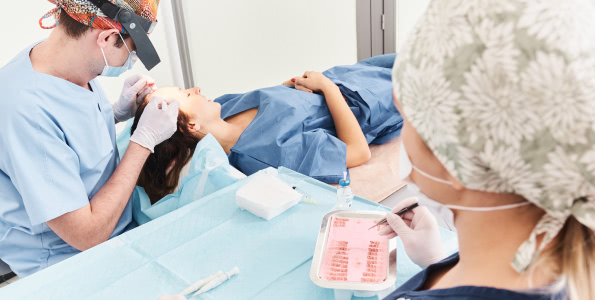
Once the surgery has been completed, the patient receives detailed after-care instructions along with postoperative discharge instructions. All instructions will be discussed with the doctor and the patient can return to their regular activity the next day, except for heavy exercise, which must be avoided for 2 weeks after the surgery.

Immdiatly post fue hair transplant
he follicular units have been carefully removed from the donor area, they are cleaned and examined under magnification and then placed into the skin, the recipient area. (as per the image). The immediate result are tiny grafts with a short hair present just over the skin surface.
Your scalp will be slightly reddish pink with the grafts in the recipient still freshly placed and the small round wounds in the donor area beginning to close and heal. In general, there is little to no pain in either area, a pain killer can be taken and occasionally some numbness.
Do not touch the recipient area/the grafted area and ideally sleep in an upright position with a travel type pillow giving your neck support. Avoid drinking alcohol, spicy foods or anything that can thin the blood, smoking, vitamins etc. Follow the instruction provided and if you have a doubt contact the Clinic.
The redness will start to diminish slightly, and small scabs or crust appear over both areas.
Refrain from touching the recipient area.
If hairline work there maybe some swelling over the forehead, this is natural and causes not danger medically and will naturally go over the next days. The scabbing will start to remove and the skin show signs of returning to normal.
Although the grafts are embedded after four days be careful not to scratch or rub the grafted area. Avoid prolonged exposure to the sun or chlorinated water.
Much of the scabbing or crust over the grafts will have removed but gentle washing will help to keep your scalp clean. In the donor the small punch marks are healing and becoming harder to see especially as your surrounding hair has grown a little longer. Any slight irritation is part of the natural healing process
Shampooing will help to relieve any mild discomfort and clean both the recipient and donor areas. Moisturising the scalp will help reduce any irritation.
The hair follicles enter a resting phase and the hair shaft begins to shed from the hair follicle that is embedded in the skin. The odd spot may appear over the scalp which is normal, and no action is required.
Keep your scalp clean with regular washing and do not panic if you see small hair shafts shedding when you wash
A relatively small percentage of the transplanted hair grafts begin to regrow; the hair quality may be finer and wispier than normal, and this will change over the months. The existing hair may also be affected by the hair transplant and will also mature over time
Maintain washing your hair regularly as you would normally, refrain from prolonged exposure to the sun and chlorinated water.
More of the transplanted hair is now growing and improving in quality and strength and a good time frame to assess the progress at 6 months.
Maintain common sense approach to skin and hair care and if in doubt ask your Clinic.
With more transplanted hair growth being visible month on month and the hair quality improving and maturing all the time as the hair goes through growth cycles.
Styling and cutting begins to become more flexible as more hair is now growing and the design becoming easier to manage as the hair grows longer.
By this time all your transplanted hair will have grown and almost all have fully matured over the month with body and fullness.
Enjoy your new hair!
Each case is different and the price depends on the desired results, which in turn depend on the type of hair, their thickness and number per follicle. Therefore, the best method to get a price estimate is to fill in an online consultation form and to send photos of the back, sides of your head and the areas requiring hair reconstruction. Photos should be taken in good light and be sharp. Approximate prices:
Receding hairline (depending on the extent of the procedure)
Front of the head with hairline reconstruction
Head crown
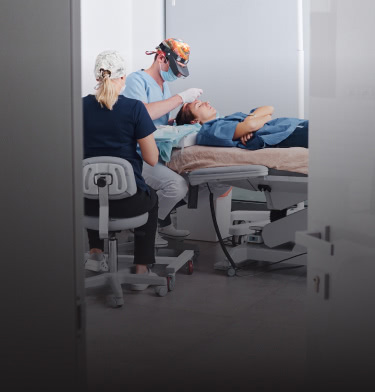
FUE-Regenera
During a single session, when a patient is at the same time a donor and recipient of an autological transplant, we can stimulate the transplant area with progenitor cells and growth factors sourced from the donor areas.
Major advantages of this method include:
Shorter healing time
Skin regeneration and preparation for FUE
Quicker growth of the transplanted hair
Strengthening weak hair
Stopping hair loss
+ price of the standard FUE procedure
Are you a public person and you do not want anyone else to be
aware of your hair loss issues? The service is designed to meet the needs of patients and is dedicated to anyone who wants to keep their baldness issues secret.
HairCenter Kierach offers VIP consultations. Ask for appointment availability at recepcja@drkierach.pl
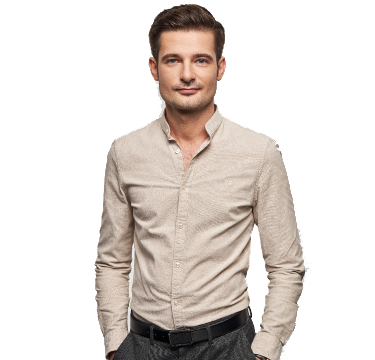
Fast appointment
FUE = FUE price + 30%
Effects of Hair Transplantation
of hair transplantation with FUE method
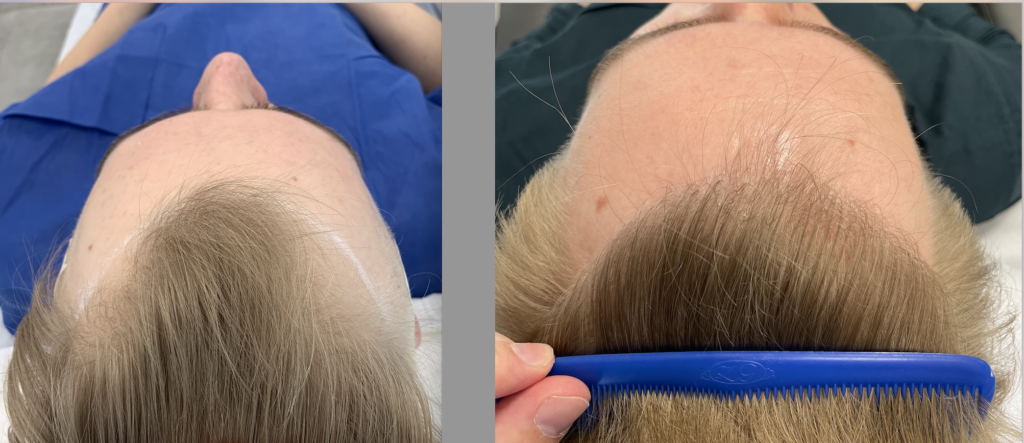
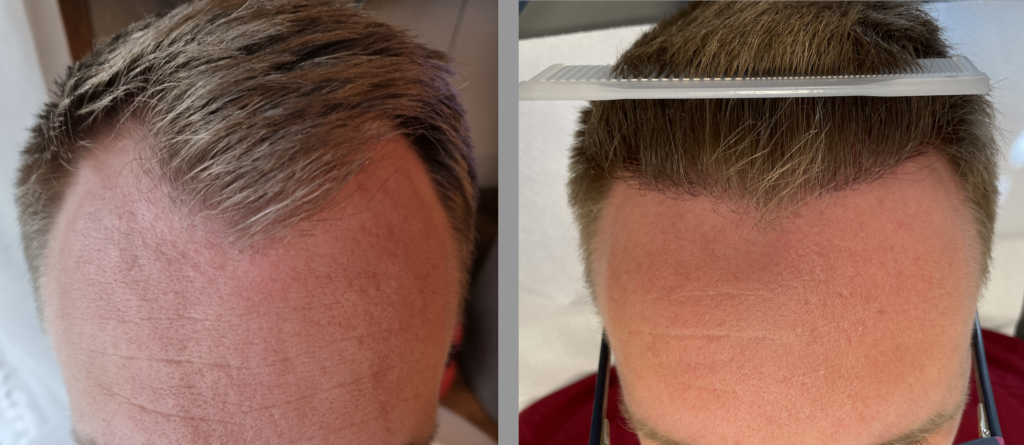
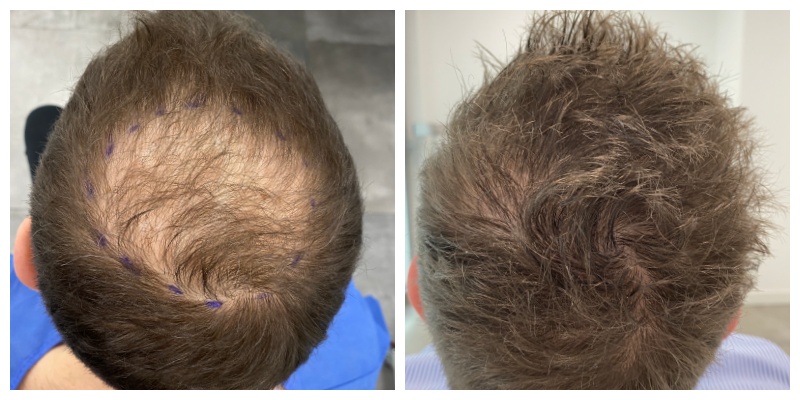



Take advantage of our free online consultation!
Start consultation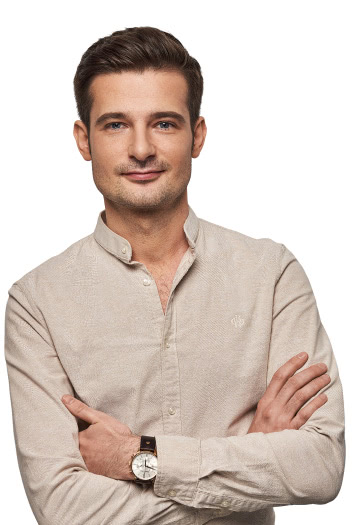
Patients interested in hair transplant have many questions starting with what FUE is, what does the procedure look like and ending with how long do the results last. We prepared a list of frequently asked questions on FUE and we hope that these will help to explain the procedure.
